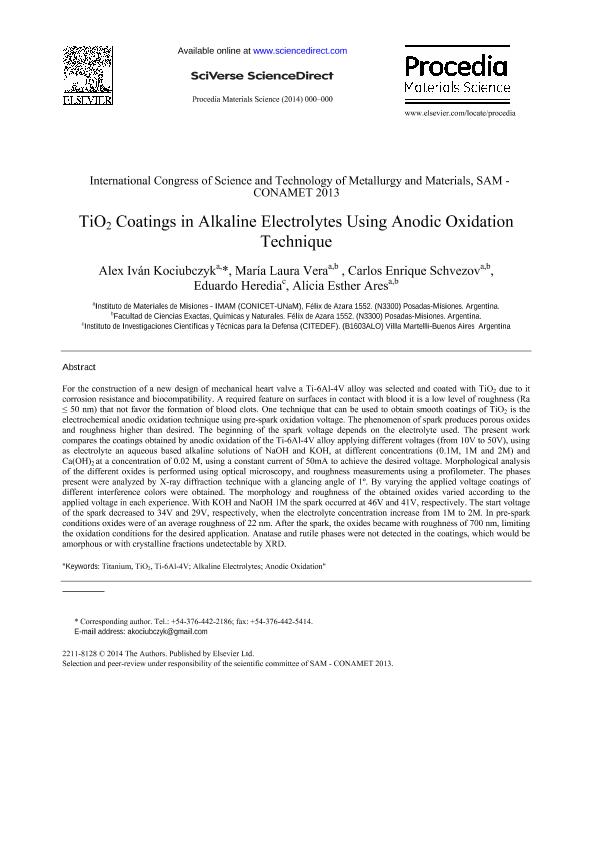Mostrar el registro sencillo del ítem
dc.contributor.author
Kociubczyk, Alex Iván

dc.contributor.author
Vera, Maria Laura

dc.contributor.author
Schvezov, Carlos Enrique

dc.contributor.author
Heredia, Eduardo
dc.contributor.author
Ares, Alicia Esther

dc.date.available
2016-12-19T18:39:53Z
dc.date.issued
2014-06
dc.identifier.citation
Kociubczyk, Alex Iván; Vera, Maria Laura; Schvezov, Carlos Enrique; Heredia, Eduardo; Ares, Alicia Esther; TiO2 Coatings in Alkaline Electrolytes Using Anodic Oxidation Technique; Elsevier Science; Procedia Materials Science; 8; 6-2014; 65-72
dc.identifier.issn
2211-8128
dc.identifier.uri
http://hdl.handle.net/11336/9753
dc.description.abstract
For the construction of a new design of mechanical heart valve a Ti-6Al-4V alloy was selected and coated with TiO2 due to it corrosion resistance and biocompatibility. A required feature on surfaces in contact with blood it is a low level of roughness (Ra ≤ 50 nm) that not favor the formation of blood clots. One technique that can be used to obtain smooth coatings of TiO2 is the electrochemical anodic oxidation technique using pre-spark oxidation voltage. The phenomenon of spark produces porous oxides and roughness higher than desired. The beginning of the spark voltage depends on the electrolyte used. The present work compares the coatings obtained by anodic oxidation of the Ti-6Al-4V alloy applying different voltages (from 10V to 50V), using as electrolyte an aqueous based alkaline solutions of NaOH and KOH, at different concentrations (0.1M, 1M and 2M) and Ca(OH)2 at a concentration of 0.02 M, using a constant current of 50mA to achieve the desired voltage. Morphological analysis of the different oxides is performed using optical microscopy, and roughness measurements using a profilometer. The phases present were analyzed by X-ray diffraction technique with a glancing angle of 1º. By varying the applied voltage coatings of different interference colors were obtained. The morphology and roughness of the obtained oxides varied according to the applied voltage in each experience. With KOH and NaOH 1M the spark occurred at 46V and 41V, respectively. The start voltage of the spark decreased to 34V and 29V, respectively, when the electrolyte concentration increase from 1M to 2M. In pre-spark conditions oxides were of an average roughness of 22 nm. After the spark, the oxides became with roughness of 700 nm, limiting the oxidation conditions for the desired application. Anatase and rutile phases were not detected in the coatings, which would be amorphous or with crystalline fractions undetectable by XRD.
dc.format
application/pdf
dc.language.iso
eng
dc.publisher
Elsevier Science

dc.rights
info:eu-repo/semantics/openAccess
dc.rights.uri
https://creativecommons.org/licenses/by-nc-nd/2.5/ar/
dc.source
International Congress of Science and Technology of Metallurgy and Materials
dc.subject
Titanium
dc.subject
Tio2
dc.subject
Ti-6al-4v
dc.subject
Alkaline Electrolytes
dc.subject.classification
Ingeniería de los Materiales

dc.subject.classification
Ingeniería de los Materiales

dc.subject.classification
INGENIERÍAS Y TECNOLOGÍAS

dc.title
TiO2 Coatings in Alkaline Electrolytes Using Anodic Oxidation Technique
dc.type
info:eu-repo/semantics/article
dc.type
info:ar-repo/semantics/artículo
dc.type
info:eu-repo/semantics/publishedVersion
dc.date.updated
2016-12-16T17:54:09Z
dc.journal.volume
8
dc.journal.pagination
65-72
dc.journal.pais
Países Bajos

dc.journal.ciudad
Amsterdam
dc.description.fil
Fil: Kociubczyk, Alex Iván. Consejo Nacional de Investigaciones Cientificas y Tecnicas. Centro Cientifico Tecnológico Nordeste. Instituto de Materiales de Misiones; Argentina
dc.description.fil
Fil: Vera, Maria Laura. Universidad Nacional de Misiones; Argentina. Consejo Nacional de Investigaciones Cientificas y Tecnicas. Centro Cientifico Tecnológico Nordeste. Instituto de Materiales de Misiones; Argentina
dc.description.fil
Fil: Schvezov, Carlos Enrique. Universidad Nacional de Misiones; Argentina. Consejo Nacional de Investigaciones Cientificas y Tecnicas. Centro Cientifico Tecnológico Nordeste. Instituto de Materiales de Misiones; Argentina
dc.description.fil
Fil: Heredia, Eduardo. Ministerio de Defensa. Instituto de Investigaciones Científicas y Técnicas para la Defensa; Argentina
dc.description.fil
Fil: Ares, Alicia Esther. Universidad Nacional de Misiones; Argentina. Consejo Nacional de Investigaciones Cientificas y Tecnicas. Centro Cientifico Tecnológico Nordeste. Instituto de Materiales de Misiones; Argentina
dc.journal.title
Procedia Materials Science
dc.relation.alternativeid
info:eu-repo/semantics/altIdentifier/url/http://www.sciencedirect.com/science/article/pii/S2211812815000504
dc.relation.alternativeid
info:eu-repo/semantics/altIdentifier/doi/http://dx.doi.org/10.1016/j.mspro.2015.04.049
Archivos asociados
